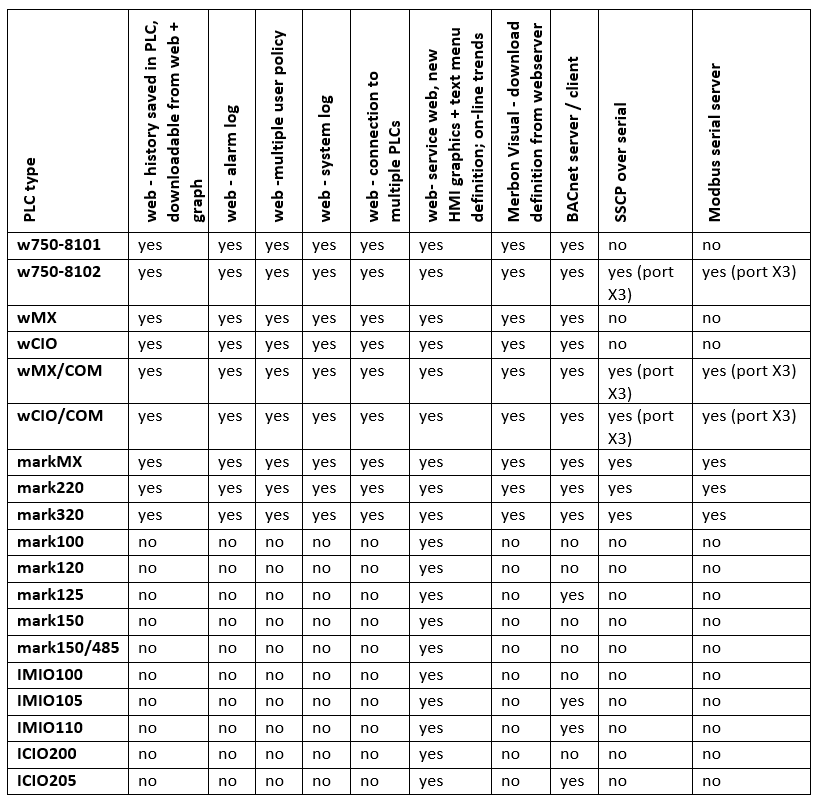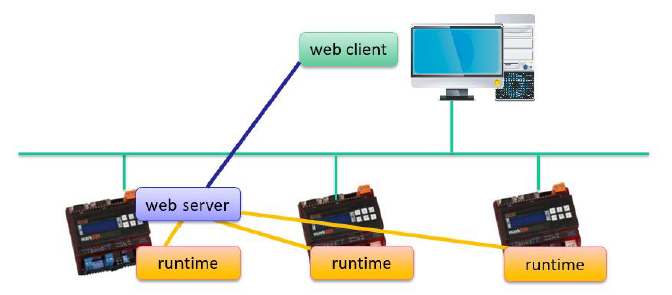Properties of hardware platforms
Runtime, or program which runs the application engineered by a programmer, executes the main activity of a PLC. It may be implemented on various hardware platforms. The platforms have different properties, such as processor computing power, operation memory and flash memory size, types and number of serial communication ports, integrated analog and digita inputs / outputs, etc. These properties determine the functionalities which a particular platform is able to support.
The following table shows new functions available in the Mervis IDE 2.4.0.1 release. Linux-based platforms (in the upper part of the table) support all functionalities, other platforms with less power do not support some of them.
- web – history saved in PLC, downloadable from web + graph:
- Part of the memory is reserved for history data saving and their presentation over web interface. The web chart shows not only the currently trended data, but also history – values which have been sampled before the web browser opened the PLC web page. Data can be downloaded as a .csv file or image, and opened in a spreadsheet or imported into another program.
- web – alarm log:
- The web contains generic (i.e. with no need for extra engineering) page with records on appearance and changes of alarm states. The alarm history is important for maintenance and service – each event is provided with a time stamp, so the exact time of appearance, acknowledgement, and reset is available. The records can be downloaded as a .csv file.
- web – multiple user policy:
- Multiple users with different access rights can be defined at the web server, the user policy is configured in the same way as at the Mervis Visual app or at the HT200 terminal. The web becomes „a small-scale SCADA“.
- web – system log:
- The web contains a generic page with system event records, such as PLC start, launching of processes, connection of users, etc. For diagnostics and service. All records can be downloaded as a .csv file.
- web – connection to multiple PLCs:
- The web server in a PLC is able to process data not only from the PLC it is running on, but also from other PLCs in the network. The system topology may be simplified.
It is not necessary to browse more PLCs to get data from the entire network. Data from different PLCs are communicated to a common web server, which is running on a single PLC in the network. All values can be displayed together in one panel or trend, the security policy may be simplified, etc.
- web – service web, new HMI graphics + text menu definition; on-line trends:
- Using the service web (generic web page) the basic network parameters can be configured, such as IP address, network mask, default gateway, and DNS server. This simplifies commissioning of PLCs with predefined applications. They do not need program upload, as the commissioning consists of configuring the network over web and of setting of control parameters and time schedulers. To change these parameters, Mervis IDE is not necessary anymore.
- A text template (same as for LCD menu definition) can be used as a web template, too. In this way, a PLC can be operated in the same way as if the user sets parameters directly over the LCD display in a PLC.
- The on-line trends are sampling values as soon as the web page containig trends is opened in a browser. Data are not stored in the PLC, the trend is deleted if the browser window is closed. On-line trends help to diagnose the plant behaviour in time on a temporary basis.
BACnet server / client
BACnet is a standardized, manufacturer-independent communication protocol, developed for building control applications. A PLC may operate as a BACnet server, which provides data using BACnet / UDP protocol to clients, such as SCADA workstations. Variables which have to be mapped to BACnet objects automatically just need to be marked in Mervis IDE. Eleven object types are supported: analog, binary and multistate inputs, outputs and values, as well as Schedule and Device objects.
BACnet client, on the contrary, integrates third-party systems into the Mervis Runtime. Mostly, they are air handling and conditioning units, room controllers, etc. The third-party BACnet objects are mapped to Mervis variables, and can be handled in the same way as other variables, such as those communicated from I/O modules.


